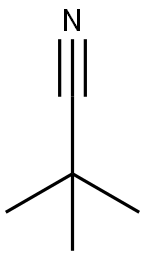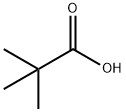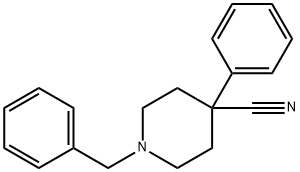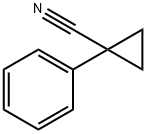Pivalonitrile , 98% , 630-18-2
Synonym(s):
tert-Butyl cyanide;Pivalonitrile
CAS NO.:630-18-2
Empirical Formula: C5H9N
Molecular Weight: 83.13
MDL number: MFCD00001847
EINECS: 211-133-0
| Pack Size | Price | Stock | Quantity |
| 5ML | RMB24.00 | In Stock |
|
| 25ML | RMB121.60 | In Stock |
|
| 100ML | RMB341.60 | In Stock |
|
| 500ML | RMB1379.20 | In Stock |
|
| others | Enquire |
PRODUCT Properties
| Melting point: | 15-16 °C (lit.) |
| Boiling point: | 105-106 °C (lit.) |
| Density | 0.752 g/mL at 25 °C (lit.) |
| refractive index | n |
| Flash point: | 40 °F |
| storage temp. | Sealed in dry,Room Temperature |
| form | Liquid |
| color | Clear colorless |
| Water Solubility | Miscible with ethanol, acetone and toluene. Slightly miscible with water. |
| BRN | 1361449 |
| Exposure limits | NIOSH: IDLH 25 mg/m3 |
| Dielectric constant | 20.09 |
| InChI | InChI=1S/C5H9N/c1-5(2,3)4-6/h1-3H3 |
| InChIKey | JAMNHZBIQDNHMM-UHFFFAOYSA-N |
| SMILES | C(#N)C(C)(C)C |
| CAS DataBase Reference | 630-18-2(CAS DataBase Reference) |
| EPA Substance Registry System | Propanenitrile, 2,2-dimethyl- (630-18-2) |
Description and Uses
Trimethylacetonitrile is a colorless and transparent liquid with high polarity and solubility. Its dielectric constant varies with temperature and frequency. At room temperature, the dielectric constant of trimethylacetonitrile is approximately 37.5, which gradually decreases at high temperatures. The high dielectric constant of trimethylacetonitrile makes it widely used in the field of electrochemistry. For example, in electrochemical reactions, trimethylacetonitrile can be used as a solvent and electrolyte to improve the efficiency and rate of the reaction. At the same time, trimethylacetonitrile can also be used as a dielectric for capacitors, to store charge and energy.
Trimethylacetonitrile used as a solvent and as a labile ligand in coordination chemistry. It is also used as an intermediate in organic synthesis. It is used in the presence of titanium(II) chloride and zinc to undergoes reductive coupling reaction of aromatic and aliphatic ketones including acyclic aliphatic ketones to give the corresponding pinacols.
Safety
| Symbol(GHS) |   GHS02,GHS06 |
| Signal word | Danger |
| Hazard statements | H225-H301+H311+H331 |
| Precautionary statements | P210-P233-P280-P301+P310-P303+P361+P353-P304+P340+P311 |
| Hazard Codes | F,T,Xi |
| Risk Statements | 11-23/24/25-36 |
| Safety Statements | 16-36/37/39-45-26-7/9 |
| RIDADR | UN 1993 3/PG 2 |
| WGK Germany | 3 |
| F | 19 |
| Hazard Note | Irritant |
| TSCA | Yes |
| HazardClass | 3 |
| PackingGroup | II |
| HS Code | 29269090 |






